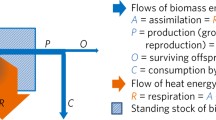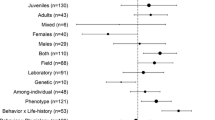Abstract
Evolutionary theory leads to the general expectation that dietary restriction will often result in increased survival probabilities, and thus increased lifespan. The reaction norm is a basic tool of evolutionary analysis that quantifies the relationship between environmental parameters and functional characters, including reproduction and longevity. In rodents, the reaction norm connecting adult longevity to caloric intake is fairly steep; small changes in intake lead to large changes in longevity. If this strong quantitative relationship were evolutionarily conserved among all mammals, then the prospects for a substantial increase in human lifespan from caloric restriction would be very good. In theory, however, reaction norms are expected to evolve for fitness related characters such as reproduction and survival. It has been shown experimentally in Drosophila that dietary reaction norms readily evolve in the laboratory, suggesting that they can do so among mammals as well, particularly over the millions of years since contemporary rodents and primates last shared a common ancestor. Our previous work crudely estimates that the dietary reaction norms of rodents and humans have diverged substantially, with a very flat dietary reaction norm for human longevity. These general principles and our specific results suggest that the benefits from human caloric restriction would be minor.
Similar content being viewed by others
References
Ball ZB, Barnes RH, Visscher MB (1947) The effects of dietary caloric restriction on maturity and senescence, with particular reference to fertility and longevity. Am J Physiol 150:511–519
Charlesworth B (1994) Evolution in age-structured populations. 2nd edn. Cambridge University Press, London
Chippindale AK, Leroi AM, Kim SB, Rose MR (1993) Phenotypic plasticity and selection in Drosophila life-history evolution. I. Nutrition and the cost of reproduction. J Evol Biol 6:171–193
Clancy DJ, Gems D, Harshman LG, Oldham S, Stocker H, Hafen E, Leevers SJ, Partridge L (2001) Extension of life-span by loss of CHICO, a Drosophila insulin receptor substrate protein. Science 202:104–106
Day T, Rowe L (2002) Developmental thresholds and the evolution of reaction norms for age and size at life-history transitions. Am Nat 159:338–350
Ellison PT, Lager C (1986) Moderate recreational running is associated with lowered salivary progesterone profiles in women. Am J Obstet Gynecol 154:1000–1003
Gage TB (2003) The evolution of human phenotypic plasticity: age and nutritional status at maturity. Hum Biol 75:521–537
Graves JL (1993) The costs of reproduction and dietary restriction: parallels between insects and mammals. Growth Dev Aging 57:233–249
Holehan AM, Merry BJ (1985) Modification of the oestrous cycle hormonal profile by dietary restriction. Mech Ageing Dev 32:63–76
Lager C, Ellison PT (1990) Effect of moderate weight loss on ovarian function assessed by salivary progesterone measurements. Am J Hum Biol 2:303–312
Leroi AM, Kim SB, Rose MR (1994) Do phenotypic manipulations reveal evolutionary trade-offs? An experimental test using Drosophila melanogaster. Am Nat 144:661–676
Merry BJ, Holehan AM (1981) Serum profiles of LH, FSH, testosterone and 5?-DHT from 21 to 1000 days of age in ad libitum fed and dietary restricted rats. Exp Gerontol 16:431–444
Phelan JP, Austad SN (1989) Natural selection, dietary restriction, and extended longevity. Growth Dev Aging 53:4–6
Phelan JP, Rose MR (2005) Why dietary restriction substantially increases longevity in animal models but won’t in humans. Aging Res Rev 4:339–350
Pletcher SD, Libert S, Skorupa D (2005) Flies and their golden apples: the effect of dietary restriction on Drosophila aging and age-dependent gene expression. Ageing Res Rev 4:451–480
Rauser CL, Mueller LD, Rose MR (2004) Dietary restriction in Drosophila. Science (Letters) 303:1610–1611
Rose MR (1991) Evolutionary biology of aging. Oxford University Press, UK
Rose MR, Passananti HK, Matos M (2004) Methuselah flies: a case study in the evolution of aging. World Scientific Publishing, Singapore
Rose MR, Vu LN, Park SU, Graves JL (1992) Selection on stress resistance increases longevity in Drosophila melanogaster. Exp Gerontol 27:241–250
Service PM, Hutchinson EW, MacKinley MD, Rose MR (1985) Resistance to environmental stress in Drosophila melanogaster selected for postponed senescence. Physiol Zool 58:380–389
Stearns SC (1992) The evolution of life histories. Oxford University Press, UK
Tatar M, Kopelman A, Tu MP, Yin CM, Garofalo RS (2001) Mutant in Drosophila insulin receptor homologue extend lifespan and impair neuroendocrine function. Science 292:107–110
Williams GC (1957) Pleiotropy, natural selection, and the evolution of senescence. Evolution 11:398–411
Williams GC (1966) Natural selection, the cost of reproduction, and a refinement of Lack’s principle. Am Nat 100:687–690
Author information
Authors and Affiliations
Corresponding author
Rights and permissions
About this article
Cite this article
Phelan, J.P., Rose, M.R. Caloric Restriction Increases Longevity Substantially only When the Reaction Norm is Steep. Biogerontology 7, 161–164 (2006). https://doi.org/10.1007/s10522-006-9005-2
Received:
Accepted:
Published:
Issue Date:
DOI: https://doi.org/10.1007/s10522-006-9005-2




